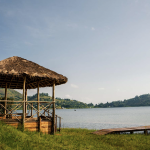Bridging the Skies: Airline Access to High-end Africa Destinations
Africa’s most iconic destinations, from the vast plains of the Serengeti to the pristine shores of Seychelles, continue to captivate high-networth travellers seeking unparalleled experiences. Yet, as the continent’s high-end travel market continues to expand, a growing concern with the journey to these remote locales often falls short of the premium experience awaiting travellers upon arrival. This challenge was highlighted in our annual exhibitor survey, where industry leaders emphasised that airline access remains a significant barrier to unlocking Africa’s full potential as an exclusive high-end destination.
For many of Africa’s top destinations, airline access remains limited. Major international carriers like British Airways, Emirates, and Qatar Airways connect global travellers to primary hubs such as Nairobi, Johannesburg, and Cape Town. However, reaching more remote areas, such as the Okavango Delta in Botswana or the Maasai Mara in Kenya, often requires multiple connections. The final leg of the journey is frequently on regional airlines.
Case Study: Qatar Airways’ Strategic Investment in Airlink
A recent example of efforts to bridge this gap is Qatar Airways’ acquisition of a 25% stake in South African regional carrier Airlink. This move underscores Qatar Airways’ commitment to expanding its operations across the African continent. Airlink currently serves more than 45 destinations in 15 African countries, and this partnership aims to enhance connectivity to some of Africa’s most remote destinations.
Qatar Airways Group CEO, Engr. Badr Mohammed Al-Meer emphasised that the investment is a testament to Africa’s potential and integral role in the airline’s future. He highlighted that the partnership demonstrates confidence in Airlink as a resilient and financially robust company. By aligning the strengths of both airlines—Qatar Airways’ extensive international network and Airlink’s regional expertise—this investment is poised to improve the overall travel experience for high-end travellers. The collaboration is expected to expand route networks, increase flight frequencies, and potentially elevate service standards on regional flights, addressing some of the key challenges to promote seamless travel in Africa’s high-end market.
Airlink’s CEO, Rodger Foster, noted that this partnership would unlock growth by increasing capacity, expanding marketing reach, and enhancing the airline’s competitiveness. The deal is expected to also align the loyalty programs of both carriers, further enriching the customer experience.
This air access gap presents a significant opportunity for the travel industry to innovate and enhance the overall experience for luxury travellers. Several potential solutions are emerging:
- Premium Charter Services: Some tour operators are already partnering with private jet companies to offer direct flights to remote airstrips. Appealing to ultra-high-net-worth travellers who prioritise comfort, convenience, and exclusivity.
- Exclusive Airline Partnerships: There is growing potential for international carriers to form strategic partnerships with regional African airlines. These collaborations could involve upgrading aircraft and elevating service standards on key routes to premium destinations, ensuring a seamless experience from start to finish.
- Infrastructure Investment: Governments and private investors could join forces to improve airport facilities and extend runways at high-end destinations. Enhanced infrastructure would allow for direct access by larger, more comfortable aircraft, eliminating the need for multiple connections.
- Innovative Aircraft Design: Aircraft manufacturers are increasingly focusing on developing planes specifically designed for the African travel industry. These aircraft are capable of landing on shorter runways while still offering a premium cabin experience, bridging the gap between accessibility and luxury.
Despite these promising developments, several challenges must be addressed to improve air access to Africa’s remote destinations:
- Regulatory Hurdles: Africa’s complex aviation regulations and bilateral agreements can make it difficult to expand services or introduce new entrants to the market. Streamlining these processes will be key to enabling growth.
- Infrastructure Costs: Upgrading airports and air traffic systems is a costly endeavour, particularly in remote regions. Securing the necessary investment may prove challenging in areas where resources are limited.
- Environmental Concerns: As air traffic increases to ecologically sensitive areas, there is a pressing need to balance tourism growth with conservation efforts. Sustainable practices must be at the forefront of any expansion plans.
- Maintaining Exclusivity: Part of the allure of Africa’s luxury destinations lies in their remoteness and exclusivity. Any efforts to improve air access must be carefully managed to preserve the unique appeal of these locations.
As Africa continues to grow, the pressure to improve air access will only increase. Forward-thinking governments, airlines, and industry stakeholders who rise to this challenge stand to gain a competitive edge. The solution will likely involve a combination of approaches: upgrading regional carriers, forming strategic partnerships, expanding infrastructure and exploring innovative travel options such as fly-in safaris.
Ultimately, seamless air access is not just about convenience – it’s about creating a holistic experience from the moment the journey begins. As Africa’s high-end tourism industry evolves, the journey to its most exclusive destinations may soon become as memorable as the destinations themselves, offering guests an unparalleled adventure from takeoff to touchdown.











